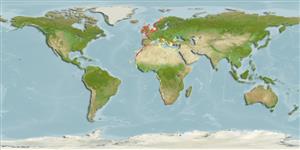Bivalvia |
Venerida |
Veneridae
Environment: milieu / climate zone / depth range / distribution range
Ecology
Benthic; brackish; depth range 0 - 40 m (Ref. 114765). Subtropical, preferred 15°C (Ref. 107945); 70°N - 35°S, 25°W - 36°E
Eastern Atlantic and the Mediterranean Sea: Norway to South Africa, east to Egypt, Gulf of Suez.
Length at first maturity / Size / Weight / Age
Maturity: Lm 2.2 range ? - ? cm Max length : 7.7 cm SHL male/unsexed; (Ref. 109255); common length : 4.0 cm SHL male/unsexed; (Ref. 437); max. reported age: 10 years (Ref. 2823)
Longevity wild refers to the synonym Venerupis pullastra (Ref. 2823). Found buried along the sub-littoral zone in fine-grained sandy or gravel substrates with less than 30% mud content (Refs. 114581, 7882). A microvore that feeds on organic detritus (Ref. 96352). Also in Refs. 2711, 96292.
Life cycle and mating behavior
Maturity | Reproduction | Spawning | Eggs | Fecundity | Larvae
Members of the class Bivalvia are mostly gonochoric, some are protandric hermaphrodites. Life cycle: Embryos develop into free-swimming trocophore larvae, succeeded by the bivalve veliger, resembling a miniature clam.
Fischer, W., G. Bianchi and W.B. Scott (eds.) 1981 Bivalves. 6: pag.var. In FAO species identification sheets for fishery purposes. Eastern Central Atlantic (fishing areas 34, 47; in part). Canada Funds-in-Trust. Ottawa, Department of Fisheries and Oceans Canada, by arrangement with the Food and AgriculturesOrganization of the United Nations, 1-7: pag.var. (Ref. 437)
IUCN Red List Status
(Ref. 130435: Version 2025-1)
CITES status (Ref. 108899)
Not Evaluated
Not Evaluated
Threat to humans
Harmless
Human uses
Fisheries: commercial
| FishSource | Sea Around Us
Tools
More information
PhysiologyOxygen consumption
Human RelatedStamps, coins, misc.
Internet sources
Estimates based on models
Preferred temperature
(Ref.
115969): 14.5 - 26.2, mean 18.8 (based on 176 cells).
Resilience
Medium, minimum population doubling time 1.4 - 4.4 years (K=0.23; tmax=10).
Fishing Vulnerability
Moderate vulnerability (38 of 100).
Climate Vulnerability
Moderate to high vulnerability (54 of 100).
Nutrients : Calcium = 149 [71, 228] mg/100g; Iron = 8.53 [1.95, 15.11] mg/100g; Protein = 9.88 [8.64, 11.12] %; Omega3 = 0.313 [0.202, 0.423] g/100g; Selenium = 61 [50, 72] μg/100g; VitaminA = 0 μg/100g; Zinc = 2.04 [0.56, 3.51] mg/100g (wet weight); based on
nutrient studies.
